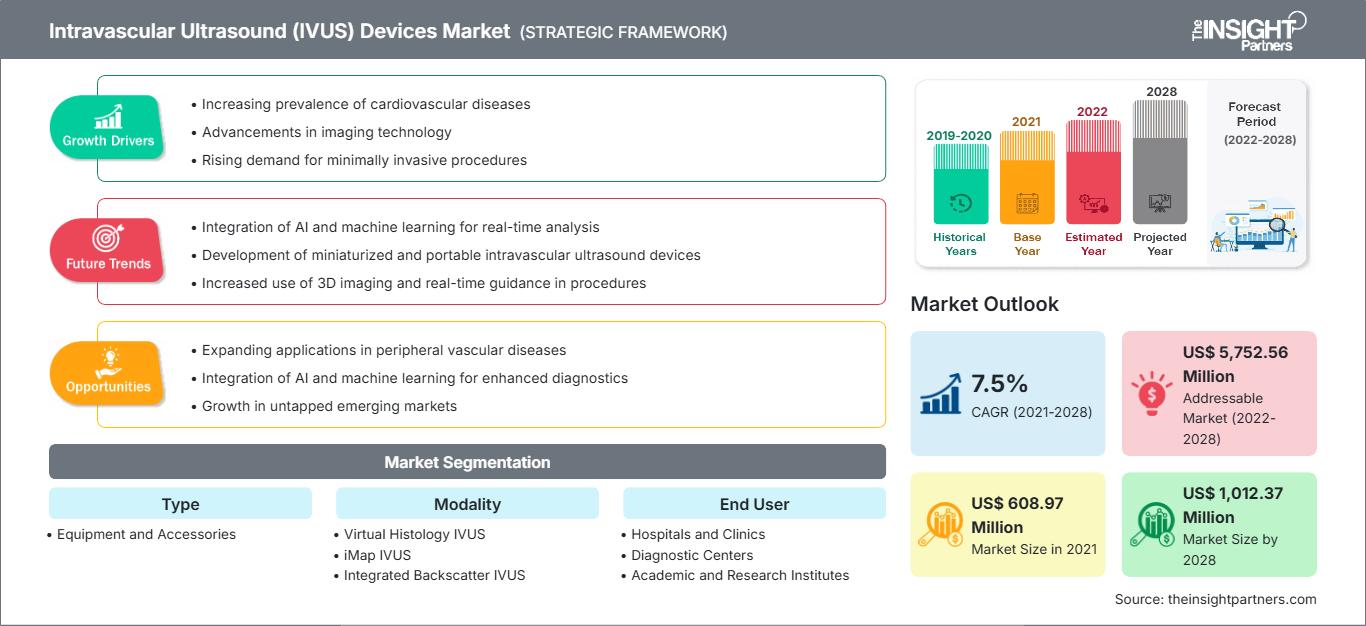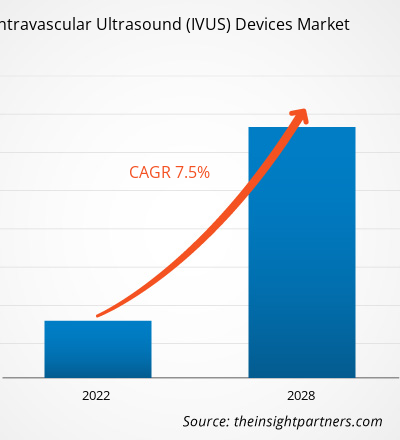[Forschungsbericht]Der Markt für intravaskuläre Ultraschallgeräte (IVUS) wird voraussichtlich von 608,97 Millionen US-Dollar im Jahr 2021 auf 1.012,37 Millionen US-Dollar im Jahr 2028 wachsen; von 2021 bis 2028 wird mit einer durchschnittlichen jährlichen Wachstumsrate (CAGR) von 7,5 % gerechnet.
Der Bericht bietet Einblicke und eine detaillierte Analyse des Marktes für intravaskuläre Ultraschallgeräte (IVUS) hinsichtlich verschiedener Parameter wie Markttrends und -chancen, Marktdynamik und einer Analyse der Wettbewerbslandschaft führender Marktteilnehmer in Nordamerika, Europa, im asiatisch-pazifischen Raum, in Süd- und Mittelamerika sowie im Nahen Osten und Afrika. Er enthält auch eine Analyse der Auswirkungen der COVID-19-Pandemie auf die Regionen.
Passen Sie diesen Bericht Ihren Anforderungen an
Sie erhalten kostenlos Anpassungen an jedem Bericht, einschließlich Teilen dieses Berichts oder einer Analyse auf Länderebene, eines Excel-Datenpakets sowie tolle Angebote und Rabatte für Start-ups und Universitäten.
Markt für intravaskuläre Ultraschallgeräte (IVUS): Strategische Einblicke

- Holen Sie sich die wichtigsten Markttrends aus diesem Bericht.Dieses KOSTENLOSE Beispiel umfasst Datenanalysen, die von Markttrends bis hin zu Schätzungen und Prognosen reichen.
Sie erhalten kostenlos Anpassungen an jedem Bericht, einschließlich Teilen dieses Berichts oder einer Analyse auf Länderebene, eines Excel-Datenpakets sowie tolle Angebote und Rabatte für Start-ups und Universitäten.
Markt für intravaskuläre Ultraschallgeräte (IVUS): Strategische Einblicke

- Holen Sie sich die wichtigsten Markttrends aus diesem Bericht.Dieses KOSTENLOSE Beispiel umfasst Datenanalysen, die von Markttrends bis hin zu Schätzungen und Prognosen reichen.
Markteinblicke
Zunahme von Herz-Kreislauf-Erkrankungen
Herz-Kreislauf-Erkrankungen sind nach wie vor die weltweit häufigste Ursache für Morbidität und Mortalität. Eine ungesunde Ernährung ist der wichtigste Lebensstilfaktor, der zu Herz-Kreislauf-Erkrankungen führt. Laut WHO sind Herz-Kreislauf-Erkrankungen eine der Todesursachen und waren 2019 für fast 17,9 Millionen Todesfälle weltweit verantwortlich.
Zu den Hauptrisikofaktoren für Herz-Kreislauf-Erkrankungen zählen Familienanamnese, ethnische Zugehörigkeit, Alter und andere Risikofaktoren: Tabakkonsum, Bluthochdruck, Fettleibigkeit, hoher Cholesterinspiegel, Bewegungsmangel, Diabetes, ungesunde Ernährung und Alkoholkonsum. Die meisten Herz-Kreislauf-Erkrankungen können durch Vorüberwachung und Vordiagnose mit intravaskulären Ultraschallgeräten verhindert werden. Daher treibt die wachsende Zahl von Herz-Kreislauf-Erkrankungen die Nachfrage nach intravaskulären Ultraschallgeräten an.
Aufgrund der COVID-19-Pandemie ist die Nachfrage nach intravaskulären Ultraschallgeräten (IVUS) gestiegen. Der Markt für intravaskuläre Ultraschallgeräte (IVUS) im asiatisch-pazifischen Raum wird in naher Zukunft voraussichtlich rasant wachsen. Dieses Wachstum ist hauptsächlich auf die Verfügbarkeit von geschulten und gut qualifizierten Technikern und die zunehmende Nutzung technologisch fortschrittlicher Diagnosegeräte zurückzuführen.
Modalitätsbasierte Erkenntnisse
Basierend auf der Modalität ist der Markt für intravaskuläre Ultraschallgeräte (IVUS) in virtuelle Histologie-IVUS, iMap-IVUS und integriertes Rückstreu-IVUS segmentiert. Im Jahr 2021 hatte das Segment der virtuellen Histologie-IVUS einen größeren Marktanteil. Das Segment iMap-IVUS wird im Prognosezeitraum jedoch voraussichtlich eine höhere durchschnittliche jährliche Wachstumsrate (CAGR) von 8,0 % verzeichnen.
Markt für intravaskuläre UltraschallgeräteMarkt für intravaskuläre Ultraschallgeräte (IVUS)
Die Analysten von The Insight Partners haben die regionalen Trends und Faktoren, die den Markt für intravaskuläre Ultraschallgeräte (IVUS) im Prognosezeitraum beeinflussen, ausführlich erläutert. In diesem Abschnitt werden auch die Marktsegmente und die geografische Lage für intravaskuläre Ultraschallgeräte (IVUS) in Nordamerika, Europa, im asiatisch-pazifischen Raum, im Nahen Osten und Afrika sowie in Süd- und Mittelamerika erörtert.Umfang des Marktberichts zu intravaskulären Ultraschallgeräten (IVUS)
Berichtsattribut
Einzelheiten
Marktgröße in 2021
US$ 608.97 Million
Marktgröße nach 2028
US$ 1,012.37 Million
Globale CAGR (2021 - 2028)
7.5%
Historische Daten
2019-2020
Prognosezeitraum
2022-2028
Abgedeckte Segmente
By Typ - Ausstattung und Zubehör
By Modalität- Virtuelle Histologie IVUS
- iMap IVUS
- Integriertes Rückstreu-IVUS
By Endbenutzer- Krankenhäuser und Kliniken
- Diagnosezentren
- akademische und Forschungsinstitute
Abgedeckte Regionen und Länder
Nordamerika- USA
- Kanada
- Mexiko
Europa- Großbritannien
- Deutschland
- Frankreich
- Russland
- Italien
- Restliches Europa
Asien-Pazifik- China
- Indien
- Japan
- Australien
- Restlicher Asien-Pazifik
Süd- und Mittelamerika- Brasilien
- Argentinien
- Restliches Süd- und Mittelamerika
Naher Osten und Afrika- Südafrika
- Saudi-Arabien
- Vereinigte Arabische Emirate
- Restlicher Naher Osten und Afrika
Marktführer und wichtige Unternehmensprofile - Koninklijke Philips N.V.
- GE Healthcare
- Siemens AG
- Boston Scientific Corporation
- Infraredx, Inc.
- Terumo Corporation
- Axle International
- Conavi Medical Inc.
- Canon Medical Systems
Dichte der Marktteilnehmer für intravaskuläre Ultraschallgeräte (IVUS): Verständnis ihrer Auswirkungen auf die Geschäftsdynamik
Der Markt für intravaskuläre Ultraschallgeräte (IVUS) wächst rasant. Dies ist auf die steigende Nachfrage der Endnutzer zurückzuführen, die auf Faktoren wie veränderte Verbraucherpräferenzen, technologische Fortschritte und ein stärkeres Bewusstsein für die Produktvorteile zurückzuführen ist. Mit der steigenden Nachfrage erweitern Unternehmen ihr Angebot, entwickeln Innovationen, um den Bedürfnissen der Verbraucher gerecht zu werden, und nutzen neue Trends, was das Marktwachstum weiter ankurbelt.
- Holen Sie sich die Markt für intravaskuläre Ultraschallgeräte (IVUS) Übersicht der wichtigsten Akteure
Markt für intravaskuläre Ultraschallgeräte (IVUS)
Die Analysten von The Insight Partners haben die regionalen Trends und Faktoren, die den Markt für intravaskuläre Ultraschallgeräte (IVUS) im Prognosezeitraum beeinflussen, ausführlich erläutert. In diesem Abschnitt werden auch die Marktsegmente und die geografische Lage für intravaskuläre Ultraschallgeräte (IVUS) in Nordamerika, Europa, im asiatisch-pazifischen Raum, im Nahen Osten und Afrika sowie in Süd- und Mittelamerika erörtert.Umfang des Marktberichts zu intravaskulären Ultraschallgeräten (IVUS)
| Berichtsattribut | Einzelheiten |
|---|---|
| Marktgröße in 2021 | US$ 608.97 Million |
| Marktgröße nach 2028 | US$ 1,012.37 Million |
| Globale CAGR (2021 - 2028) | 7.5% |
| Historische Daten | 2019-2020 |
| Prognosezeitraum | 2022-2028 |
| Abgedeckte Segmente |
By Typ
|
| Abgedeckte Regionen und Länder | Nordamerika
|
| Marktführer und wichtige Unternehmensprofile |
|

- Holen Sie sich die Markt für intravaskuläre Ultraschallgeräte (IVUS) Übersicht der wichtigsten Akteure
Typbasierte Erkenntnisse
Basierend auf dem Typ ist der Markt für intravaskuläre Ultraschallgeräte (IVUS) in Ausrüstung und Zubehör unterteilt. Im Jahr 2021 hatte das Segment Zubehör einen größeren Marktanteil, und es wird geschätzt, dass dasselbe Segment im Prognosezeitraum eine höhere CAGR von 7,7 % auf dem Markt verzeichnen wird.
Endbenutzerbasierte Erkenntnisse
Basierend auf dem Endbenutzer ist der Markt für intravaskuläre Ultraschallgeräte (IVUS) in Krankenhäuser und Kliniken, Diagnosezentren sowie akademische und Forschungsinstitute unterteilt. Im Jahr 2021 hatte das Segment Krankenhäuser und Kliniken einen größeren Marktanteil. Das Segment Diagnosezentren wird jedoch im Prognosezeitraum voraussichtlich eine höhere CAGR von 7,9 % verzeichnen.
Unternehmen wenden häufig anorganische Strategien wie Fusionen und Übernahmen an, um auf die sich ändernde Kundennachfrage einzugehen und ihren Markennamen weltweit zu behaupten. Akteure auf dem Markt für intravaskuläre Ultraschallgeräte (IVUS) verfolgen auch organische Strategien wie Produkteinführungen und -erweiterungen, um ihre Präsenz und ihr Produktportfolio weltweit zu erweitern und die wachsende Nachfrage zu befriedigen.
Nach Typ
- Geräte
Nach Modalität
- Virtuelle Histologie IVUS
- iMap IVUS
- Integrierte Rückstreuung IVUS
Nach Endbenutzer
- Krankenhäuser und Kliniken
- Akademische und Forschungsinstitute
- Diagnosezentren
Nach Geografie
- Nord Amerika
- USA
- Kanada
- Mexiko
- Europa
- Großbritannien
- Deutschland
- Frankreich
- Italien
- Spanien
- Restliches Europa
- Asien-Pazifik
- China
- Japan
- Indien
- Australien
- Südkorea
- Restlicher Asien-Pazifikraum
- Naher Osten und Afrika
- VAE
- Saudi-Arabien
- Afrika
- Restlicher Naher Osten und Afrika Afrika
- Süd- und Mittelamerika
- Brasilien
- Argentinien
- Restliches Süd- und Mittelamerika
Firmenprofile
- Koninklijke Philips NV
- GE Healthcare
- Siemens AG
- Boston Scientific Corporation
- Infraredx, Inc.
- Terumo Corporation
- Axle International
- Conavi Medical Inc.
- Canon Medical Systems
- Abbott
- ACIST Medical System
- Historische Analyse (2 Jahre), Basisjahr, Prognose (7 Jahre) mit CAGR
- PEST- und SWOT-Analyse
- Marktgröße Wert/Volumen – Global, Regional, Land
- Branchen- und Wettbewerbslandschaft
- Excel-Datensatz
Aktuelle Berichte
Erfahrungsberichte
Grund zum Kauf
- Fundierte Entscheidungsfindung
- Marktdynamik verstehen
- Wettbewerbsanalyse
- Kundeneinblicke
- Marktprognosen
- Risikominimierung
- Strategische Planung
- Investitionsbegründung
- Identifizierung neuer Märkte
- Verbesserung von Marketingstrategien
- Steigerung der Betriebseffizienz
- Anpassung an regulatorische Trends




















 Kostenlose Probe anfordern für - Markt für intravaskuläre Ultraschallgeräte (IVUS)
Kostenlose Probe anfordern für - Markt für intravaskuläre Ultraschallgeräte (IVUS)